
Space Shuttle Discovery OV-103 |
Space Shuttle Discovery OV-103 was the third operational orbiter. It flew 39 missions. It was delivered to NASA from Edwards Air Force Base on Noember 9, 1984. Its first mision was STS-41-D which took off on August 30, 1984 from the Kennedy Space Center and landed on September 5, 1984 at Edwards Air Force Base. Its final mission was STS-133 which was launched from the Kennedy Space Center on February 24, 2011 and landed at the Kennedy Space Center on March 9, 2011. It is now on display at the National Air and Space Museum, Steven F. Udvar-Hazy Center.
 Crew Module of Discovery under construction.
Crew Module of Discovery under construction.
 Discovery descending to land on Rogers Dry Lake at Edwards Air Force Base at the conclusion of STS-26 on October 4, 1988. It was the first Space Shuttle mission following the exlosion of Challenger on January 28, 1986. It launched from the Kennedy Spce Center on September 29 and deloyed a Tracking and Data Relay Satellite. Frederick H. Hauck was the Mission Commander. Richard O. Covey was the pilot. The mission specialists were John M. Lounge, David C. Hilmers, and George D. Nelson.
Discovery descending to land on Rogers Dry Lake at Edwards Air Force Base at the conclusion of STS-26 on October 4, 1988. It was the first Space Shuttle mission following the exlosion of Challenger on January 28, 1986. It launched from the Kennedy Spce Center on September 29 and deloyed a Tracking and Data Relay Satellite. Frederick H. Hauck was the Mission Commander. Richard O. Covey was the pilot. The mission specialists were John M. Lounge, David C. Hilmers, and George D. Nelson.
 Discovery descending to land at Edwards Air Force Base at the conclusion of STS-26 on October 4, 1988. The North Base facility can be seen in the foreground. I photographed this landing from a small knoll east of California City Road and north of Highway 58.
Discovery descending to land at Edwards Air Force Base at the conclusion of STS-26 on October 4, 1988. The North Base facility can be seen in the foreground. I photographed this landing from a small knoll east of California City Road and north of Highway 58.
 Discovery descending to land on Runway 22 at Edwards Air Force Base at the conclusion of STS-31 on April 29, 1990. It launched from the Kennedy Spce Center on April 24 and had deployed the Hubble Space Telescope into orbit. Lore J. Shriver was the Mission Commander. Chars F. Bolden Jr. was the pilot. The mission specialists were Bruce McCandless II, Steven A.Hawley, and Katherine D. Sullivan.
Discovery descending to land on Runway 22 at Edwards Air Force Base at the conclusion of STS-31 on April 29, 1990. It launched from the Kennedy Spce Center on April 24 and had deployed the Hubble Space Telescope into orbit. Lore J. Shriver was the Mission Commander. Chars F. Bolden Jr. was the pilot. The mission specialists were Bruce McCandless II, Steven A.Hawley, and Katherine D. Sullivan.
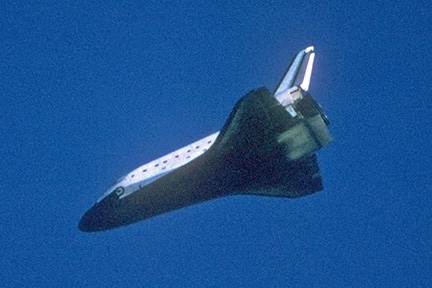 Discovery descending to land on Runway 22 at Edwards Air Force Base at the conclusion of STS-31 on April 29, 1990. I photographed this landing from the public viewing area on the east side of Rogers Dry Lake.
Discovery descending to land on Runway 22 at Edwards Air Force Base at the conclusion of STS-31 on April 29, 1990. I photographed this landing from the public viewing area on the east side of Rogers Dry Lake.
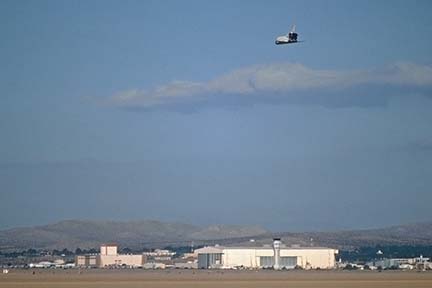 Discovery descending to land on Runway 22 at Edwards Air Force Base at the conclusion of STS-31 on April 29, 1990.
Discovery descending to land on Runway 22 at Edwards Air Force Base at the conclusion of STS-31 on April 29, 1990.
STS-42 Landing at Edwards AFB, January 30, 1992: Discovery landed at Edwards AFB at the conclusion of STS-42 on January 30, 1992. It launched from the Kennedy Spce Center on January 22 and carried the International Microgravity Laboratory-1 (IML-1), a pressurized crewed Spacelab module, to explore the effects of weightlessness on living organisms and materials processing. Ronald J. Grabe was the Mission Commander. Stephen S. Oswald was the pilot. The mission specialists were Norman E. Thagard, William F. Readdy, and David C. Hilmers. The Payoad Specialiists were Canadian Roberta L. Bondar, and German Ulf Merbold.
Due to unfavorable weather conditions in Florida, Discovery was diverted to Edwards Air Force Base at the conclusion of mission STS-92 on Tuesday, October 24. It was the twenty-eighth flight of Discovery. It had delivered the Z1 truss, Control Moment Gyros, Pressurized Mating Adapter-3 (PMA-3) (mounted on a Spacelab pallet) and two DDCU (Heat pipes) to the International Space Station. Brian Duffy was the Mission Commander. Pamela A. Melroy was the pilot. The mission specialists were Japanese Koichi Wakata, William S. McArthur, Peter J.K. Wisoff, Michael E. López-Alegría, and Leroy Chiao.
The departure of Discovery on the 747 Shuttle Carrier Aircraft was initially scheduled for sunrise on Tuesday, October 31.
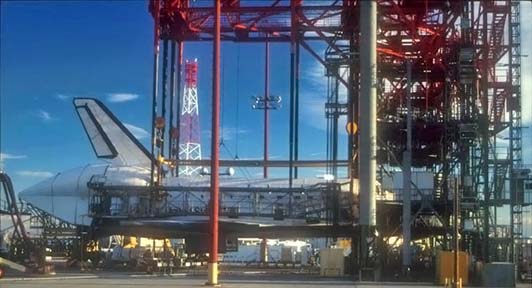 As of Monday afternoon, the shuttle was sitting on its
landing gear under the Mate/Demate Device. The yellow
cradle of the crane was attached to Discovery at the hoist points
on the sides of its fuselage. NASA technicians were working
to install the large cone on the tail that smooths the airflow
around the orbiter while it is being carried on the 747.
As of Monday afternoon, the shuttle was sitting on its
landing gear under the Mate/Demate Device. The yellow
cradle of the crane was attached to Discovery at the hoist points
on the sides of its fuselage. NASA technicians were working
to install the large cone on the tail that smooths the airflow
around the orbiter while it is being carried on the 747.
 The first 747 Shuttle Carrier Aircraft, N905NA was waiting next to the Shuttle
maintenance hangar. It was modified from American Airlines 747-123 N9668 which first flew on October 15, 1970. Its Boeing construction number is 20107. It made its first flight on October 15, 1970, and was delivered to American Airlines two weeks later. NASA acquired it on July 18, 1974. It can be distinguised from the other Shuttle Carrier Aircraft, N911NA by the number of windows on the upper deck. There are only two windows on the upper deck of N905NA. N911NA is ex-Japan Airlines 747-146SR, JA8117.
The first 747 Shuttle Carrier Aircraft, N905NA was waiting next to the Shuttle
maintenance hangar. It was modified from American Airlines 747-123 N9668 which first flew on October 15, 1970. Its Boeing construction number is 20107. It made its first flight on October 15, 1970, and was delivered to American Airlines two weeks later. NASA acquired it on July 18, 1974. It can be distinguised from the other Shuttle Carrier Aircraft, N911NA by the number of windows on the upper deck. There are only two windows on the upper deck of N905NA. N911NA is ex-Japan Airlines 747-146SR, JA8117.
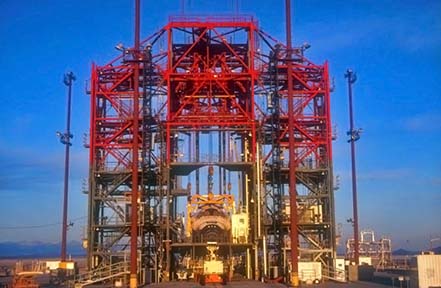 That evening
technicians began to encounter problems with the alignment of the
tail cone.
That evening
technicians began to encounter problems with the alignment of the
tail cone.
 After sunset, the first of the work
lights were coming on.
After sunset, the first of the work
lights were coming on.
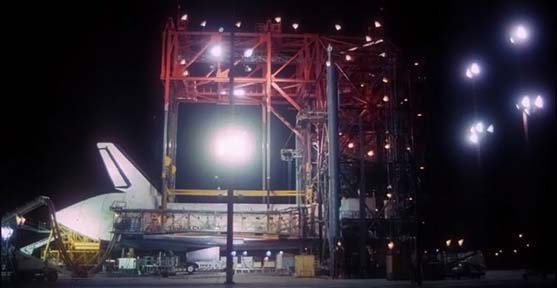 Later, the scene was entirely lit up under flood
lights.
Later, the scene was entirely lit up under flood
lights.
 Discovery in Mate/Demate Device and the 747 Shuttle Carrier
Aircraft.
Discovery in Mate/Demate Device and the 747 Shuttle Carrier
Aircraft.
 Discovery in Mate/Demate Device.
Discovery in Mate/Demate Device.
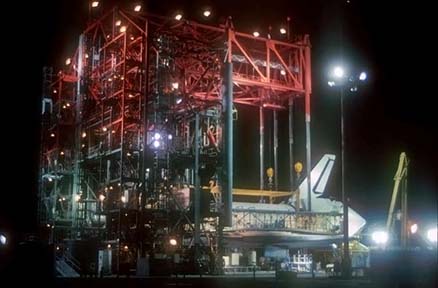 Discovery in Mate/Demate Device.
Discovery in Mate/Demate Device.
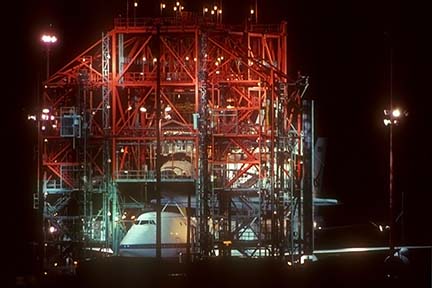 The 747 Shuttle Carrier Aircraft had been moved into position under the Discovery in the early morning of November 2, 2000.
The 747 Shuttle Carrier Aircraft had been moved into position under the Discovery in the early morning of November 2, 2000.
Twenty-three years earlier, Enterprise OV-101 and 747-SCA N905NA wait in the Mate/Demate Device for the fourth Approach and Landing Test flight before dawn on October 12, 1977.
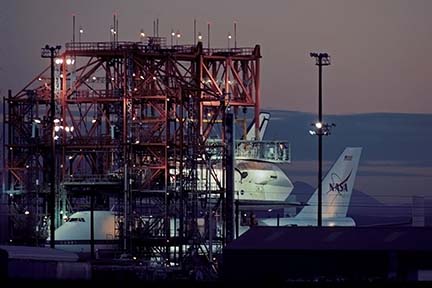 Discovery on 747-123 Shuttle Carrier Aircraft N905NA in the Mate/Demate Device. There is a short period in the early morning when the artificial light on the Mate/Demate Device and the natural light of the sky in the background are nicely balanced.
Discovery on 747-123 Shuttle Carrier Aircraft N905NA in the Mate/Demate Device. There is a short period in the early morning when the artificial light on the Mate/Demate Device and the natural light of the sky in the background are nicely balanced.
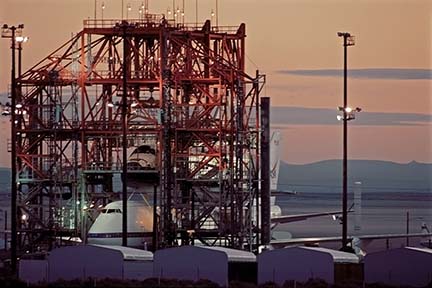 Soon the
light of day overwhelms the aritificial lights of the Mate/Demate Device.
Soon the
light of day overwhelms the aritificial lights of the Mate/Demate Device.
 The first rays of the rising sun illuminate the piggyback pair as final preparations for their departure are concluded.
The first rays of the rising sun illuminate the piggyback pair as final preparations for their departure are concluded.
It was going on 9:00 when the 747 turned onto the main runway.
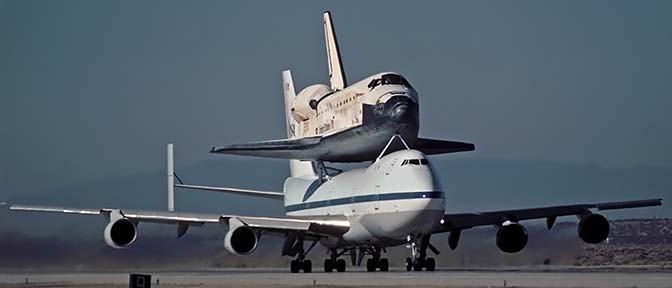 The radio
crackled with clearance from the tower and the 747 began to roll.
The radio
crackled with clearance from the tower and the 747 began to roll.
Twenty-three years earlier, Enterprise OV-101 and 747-SCA N905NA take off on the fourth Approach and Landing Test flight on October 12, 1977. This was the first of two glide flights that the Enterprise made without the streamlined tailcone. A taller mount supported the front end of the shuttle to increase the rate of separation of the two airplanes when the shuttle was released for its glide flight. NASA used Northrop T-38A Talons as chase planes in those days.
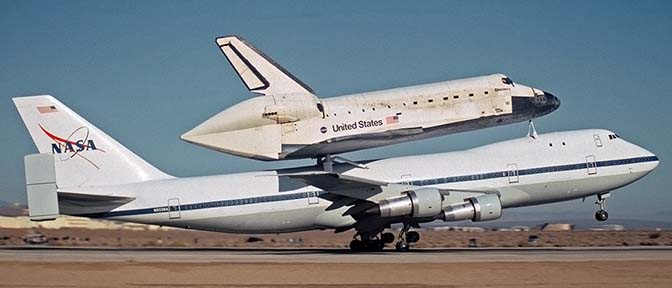 The 747 with Discovery lifted off after a roll of nearly two miles.
The 747 with Discovery lifted off after a roll of nearly two miles.
You can buy framed prints or greeting cards of this photograph.
Discovery was delivered to Orbiter Processing Facility bay 1 at the Kennedy Space Center, Florida.
STS-114 was Discovery's thirty-first orbital mission. It was the first return to flight of the Space Shuttle following the loss of Columbia. The flight carried the Raffaello Multi-Purpose Logistics Module, built by the Italian Space Agency, as well as the External Stowage Platform-2, which was mounted to the port side of the Quest Airlock. They deployed MISSE 5 to the station's exterior, and replaced one of the ISS's Control Moment Gyroscopes (CMG). The CMG was carried up on the LMC (Lightweight Multi-Purpose Experiment Support Structure Carrier) at the rear of the payload bay, together with the TPS Repair Box. Eileen Collins was the Mission Commander. James M. Kelly was the pilot. The mission specialists were Japanese Soichi Noguchi, Stephen K. Robinson, Andrew S. W. Thomas, Wendy B. Lawrence, and Charles J. Camarda. Bad weather at the Kennedy Space Center resulted in Discovery diverting to Edwards Air Force Base at the conclusion of the mission.
Discovery departed from Runway 22 at Edwards Air Force Base on 747 Carrier Aircraft NASA Nine Zero Five at 8:31 A.M. PDT Friday, August 19, 2005. It was returning to the Kennedy Space Center. It landed at Altus Air Force Base, Oklahoma at 1:31 P.M. CDT. It arrived at Barksdale Air Force Base at 5:46 P.M. The shuttle remained at Barksdale Air Force Base on Saturday and continued to the Kennedy Space Center on Sunday, arriving at 10:00 A.M. EDT. Discovery was scheduled to perform the next Space Shuttle mission in March 2006.
 Paralift Incorporated's Douglas DC-3-G202A, N20TW took off shortly before the 747 Shuttle Carrier Aircraft lined up on Runway 22.
Paralift Incorporated's Douglas DC-3-G202A, N20TW took off shortly before the 747 Shuttle Carrier Aircraft lined up on Runway 22.
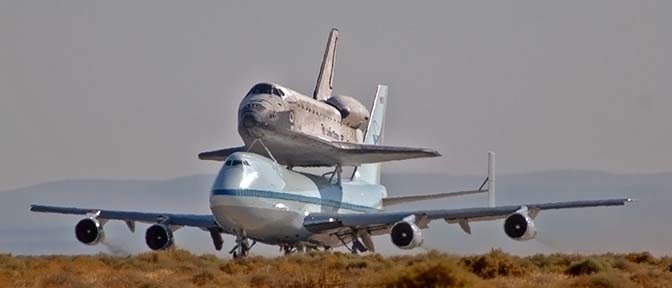 Boeing 747 Shuttle Carrier Aircraft, N905NA flies under the call sign NASA Nine Zero Five.
Boeing 747 Shuttle Carrier Aircraft, N905NA flies under the call sign NASA Nine Zero Five.
Twenty-eight years earlier: The same 747-SCA, N905NA takes off with Enterprise at the beginning of the first Approach and Landing Test (ALT-1) on August 12, 1977. The American Airlines heritage of the 747-SCA was still apparent.
You can buy framed prints or greeting cards of this photograph.
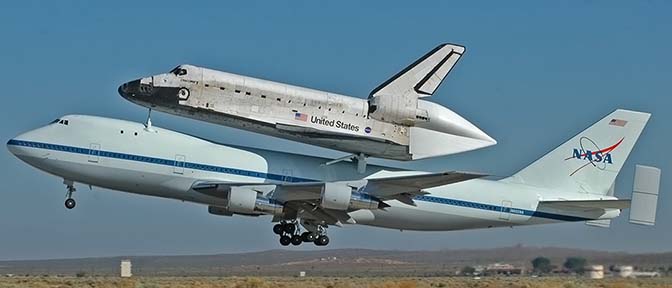 The 747-SCA lifted off farther down the runway and climbed more slowly than I expected. It was just rising from the ground 12,000 feet along the runway. Discovery was particularly heavy, with much of the material that it had unloaded from the International Space Station still stowed in its payload bay.
The 747-SCA lifted off farther down the runway and climbed more slowly than I expected. It was just rising from the ground 12,000 feet along the runway. Discovery was particularly heavy, with much of the material that it had unloaded from the International Space Station still stowed in its payload bay.
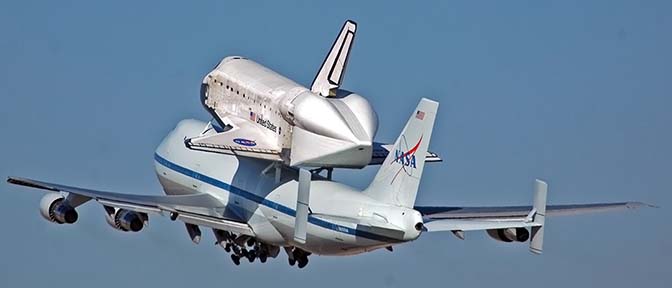 The piggyback stack remained close to the ground.
The piggyback stack remained close to the ground.
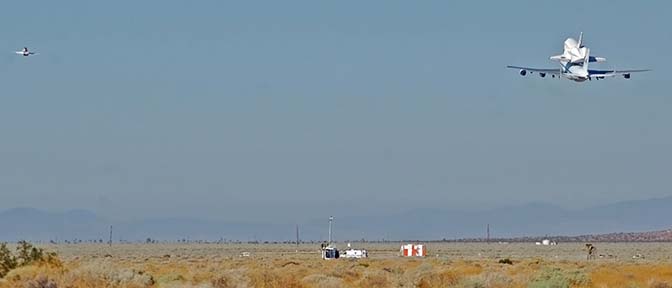 NASA Eight Five Two maintained formation with the 747-SCA and Discovery as they receded to the west.
NASA Eight Five Two maintained formation with the 747-SCA and Discovery as they receded to the west.
STS-128 was Discovery's thirty-seventh orbital mission. The flight carried the Multi-Purpose Logistics Module Leonardo. Frederick W. Sturckow was the Mission Commander. Kevin A. Ford was the pilot. The mission specialists were Patrick G. Forrester, José M. Hernández, John D. Olivas, Swedish Christer Fuglesang, and Nicole Stott. Stott remaned aboard the International Space Station after the mission, and was replaced by Timothy Kopra on the return flight. Bad weather over Florida forced Discovery to wave off from its primary landing site and land at Edwards air Force Base in California. Rain showers and thunderstorms were too close to the landing runway at the Kennedy Space Center. Deteriorating weather forecst for Saturday in California prompted mission planners to direct the shuttle crew to land on Friday. The Orbital Maneuvering System engines were fired at 4:47 PM PDT to begin the descent to landing.
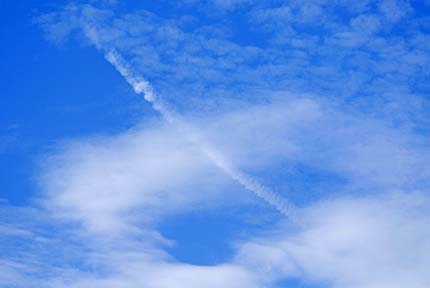 The arrival of Discovery was announced by two loud, sharp sonic booms that echoed from the surrounding desert. The orbiter left a short contrail as it descended toward the cloud deck.
The arrival of Discovery was announced by two loud, sharp sonic booms that echoed from the surrounding desert. The orbiter left a short contrail as it descended toward the cloud deck.
 Discovery made a sweeping turn that took it over Highway 58 on the north side of the base.
Discovery made a sweeping turn that took it over Highway 58 on the north side of the base.
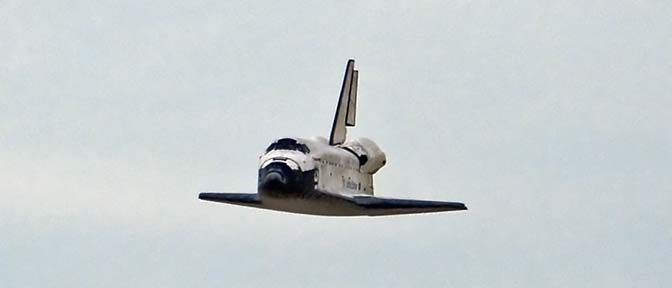 Discovery lined up with Runway 22 with its landing gear still retracted.
Discovery lined up with Runway 22 with its landing gear still retracted.
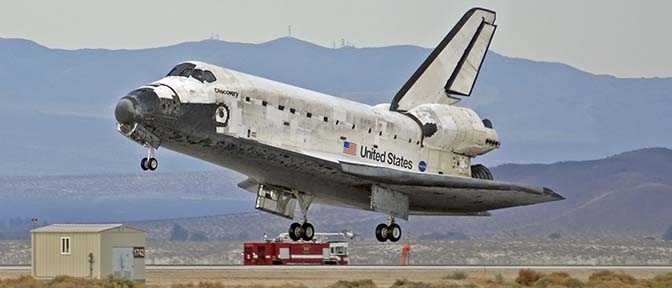 Fire trucks stand by along the runway as the shuttle glides past.
Fire trucks stand by along the runway as the shuttle glides past.
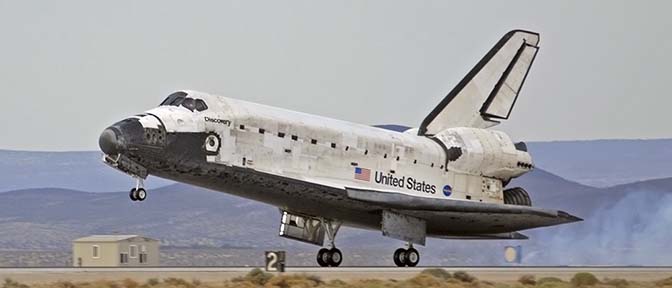 Discovery scrubs smoke from its tires as it touches down on Runway 22 at 5:53 PM.
Discovery scrubs smoke from its tires as it touches down on Runway 22 at 5:53 PM.
You can buy framed prints or greeting cards of this photograph.
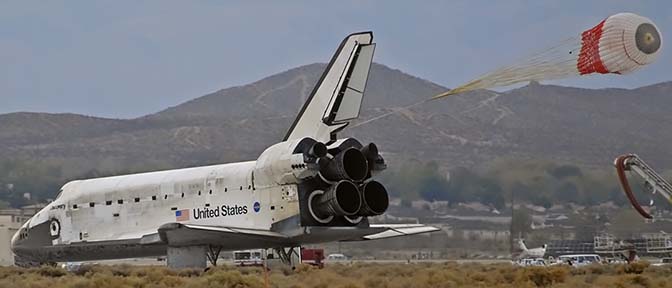 The drag chute is deployed after the nose wheel contacts the runway.
The drag chute is deployed after the nose wheel contacts the runway.
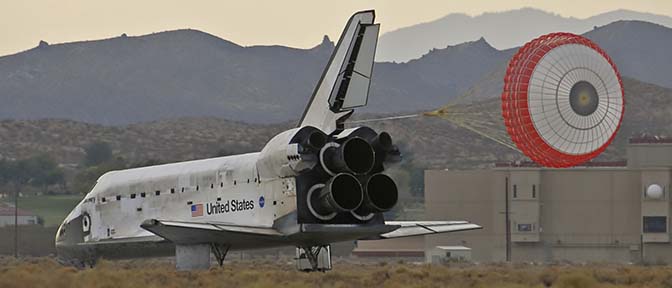 The drag chute unfurls to its full diameter as the orbiter slows to a halt. Note the tight clustering of the engine nozzles.
The drag chute unfurls to its full diameter as the orbiter slows to a halt. Note the tight clustering of the engine nozzles.
 Technicians check for the presence of fumes from the orbiter's systems before the service vehicles approach Discovery. The engine nozzles have been moved to a position that allows any rain to drain out.
Technicians check for the presence of fumes from the orbiter's systems before the service vehicles approach Discovery. The engine nozzles have been moved to a position that allows any rain to drain out.
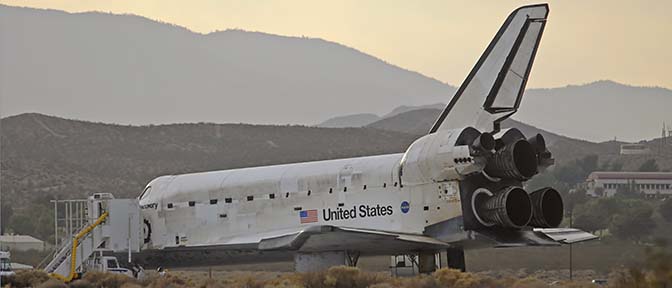 The boarding stairs approach the entrance hatch on the side of the orbiter.
The boarding stairs approach the entrance hatch on the side of the orbiter.
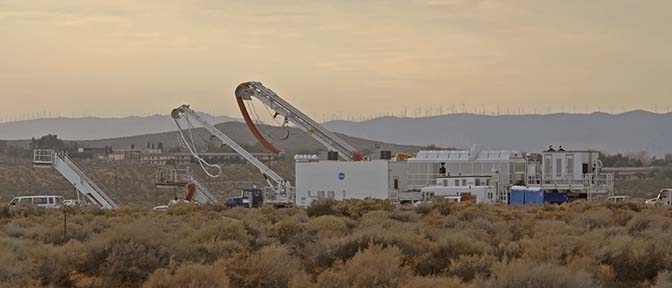 Service vehicles stand by immediately after the landing.
Service vehicles stand by immediately after the landing.
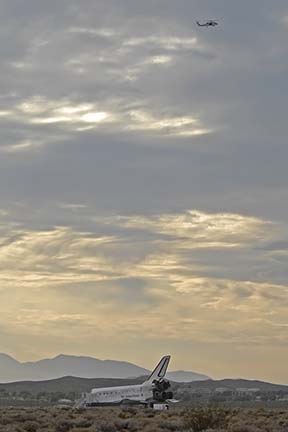 SH-60F Seahawk BuNo 163286 orbits on the far side of Discovery.
SH-60F Seahawk BuNo 163286 orbits on the far side of Discovery.
 A passenger transporter approaches Discovery to offload the asronauts.
A passenger transporter approaches Discovery to offload the asronauts.
 UH-1H Huey 74-22459 orbits at a lower altitude than the Seahawk.
UH-1H Huey 74-22459 orbits at a lower altitude than the Seahawk.
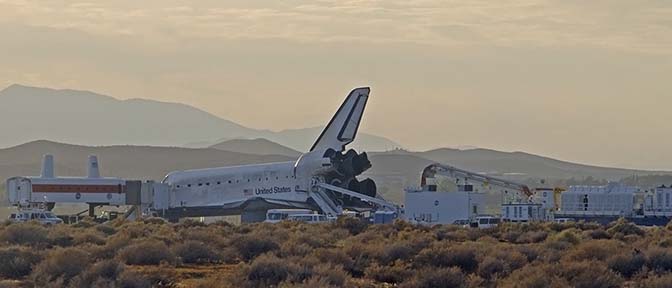 The service vehicles approach Discovery and connections are made to pump cool, inert gas into the orbiter.
The service vehicles approach Discovery and connections are made to pump cool, inert gas into the orbiter.
Discovery was suspended from the Mare/Demate Device at the NASA Dryden Flight Research Center as it was prepared for loading aboard the Boeing 747 Carrier Aircraft on Thursday. The 747 is scheduled to take off on Sunday morning for the flight to the Kennedy Space Center.
You can buy framed prints or greeting cards of this photograph.
You can buy framed prints or greeting cards of this photograph.
Boeing 747 Carrier Aircraft N911NA took off with Discovery at 6:20 AM PDT on Sunday morning for the ferry flight to the Kennedy Space Center. The first stop will be at Amarillo, Texas. The pair will continue to Naval Air Station Fort Worth, Texas later in the day. They made the third leg of the flight the foloowing day.
You can buy framed prints or greeting cards of this photograph.
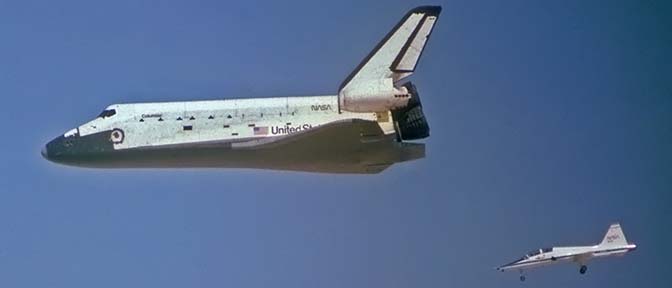 More pictures from Space Shuttle events.
More pictures from Space Shuttle events.
You can buy a 2020 calendar featuring my photographs of Space Shuttle Carrier Aircraft.
A dozen photos of 747 Shuttle Carrier Aircraft. Events depicted include:
747-SCA N905NA/Enterprise Approach and Landing Test 1 take-off on August 12, 1977.
747-SCA N905NA/Enterprise Approach and Landing Test 4 take-off on October 12, 1977.
747-SCA N905NA/Columbia delivery take-off on March 20, 1979.
747-SCA N905NA/Challenger static and departure take-off on July 4, 1982.
747-SCA N911NA/Endeavor delivery take-off from Palmdale on May 2, 1991.
747-SCA N905NA/Columbia landing at Palmdale on September 25, 1999.
747-SCA N905NA/Discovery take-off on November 2, 2000.
747-SCA N905NA/Atlantis take-off on July 1, 2007.
747-SCA N911NA/Endeavor take-off on December 10, 2008.
747-SCA N911NA/Discovery take-off on September 20, 2009.
747-SCA N905NA/Endeavor flyover at LAX, September 21, 2012.
 Put a copy of the Shuttle Carrier Aircraft 2020 calendar in your Lulu.com shopping cart for $14.95.
Put a copy of the Shuttle Carrier Aircraft 2020 calendar in your Lulu.com shopping cart for $14.95.
You can buy a 2020 calendar featuring my photographs of Space Shuttle Endeavour at Edwards Air Force Base.
Bad weather caused the Space shuttle Endeavour to divert to Edwards Air Force Base at the conclusion of STS-126 on November 30, 2007. Following servicing in the Mate/Demate Device, it departed from Edwards on the back of 747 Carrier Aircraft N911NA on December 10.
 Put a copy of the Space Shuttle Endeavour at Edwards Air Force Base: 2020 calendar in your Lulu.com shopping cart for $14.95.
Put a copy of the Space Shuttle Endeavour at Edwards Air Force Base: 2020 calendar in your Lulu.com shopping cart for $14.95.
You can buy a 2020 calendar featuring my photographs of Space Shuttle Discovery at Edwards Air Force Base.
A dozen photographs of the Space Shuttle Discovery at Edwards Air Force Base. Bad weather at the Kennedy Space Center caused the Space shuttle Discovery to divert to Edwards Air Force Base at the conclusion of mission STS-128 on September 11, 2009. Following servicing in the Mate/Demate Device, it departed from Edwards on the back of 747 Carrier Aircraft N911NA on September 20.
 Put a copy of the Space Shuttle Discovery at Edwards Air Force Base: 2020 calendar in your Lulu.com shopping cart for $14.95.
Put a copy of the Space Shuttle Discovery at Edwards Air Force Base: 2020 calendar in your Lulu.com shopping cart for $14.95.
You can buy a 2020 calendar featuring my photographs of Space Shuttle Endeavour's Final Flights.
A dozen photos of Space Shuttle Endeavour's Final Flights. Boeing 747-Shuttle Carrier Aircraft N905NA and Space Shuttle Endeavour arrived at Edwards Air Force Base from Biggs Army Airfield on September 20, 2012. The pair were placed on static display at the NASA Dryden Flight Research Center that afternoon. The 747/Shuttle stack departed from Edwards Air Force Base on the morning of September 21. It toured California and several landmarks in the LA Basin. It made two low passes over Los Angeles International Airport before making its final landing. The 747-SCA was flown to Edwards Air Force Base on September 24 where it was retired. The Endeavour ison display at the California Science Center.
 Put a copy of the Space Shuttle Endeavour's Final Flights 2020 calendar in your Lulu.com shopping cart for $14.95.
Put a copy of the Space Shuttle Endeavour's Final Flights 2020 calendar in your Lulu.com shopping cart for $14.95.
Books and Videos about the Space Shuttle from Amazon.com |
||||||
Books |
||||||
DVDs |
||||||
Visit the Lockett Books Amazon Webstore for a selection of aviation and space related books and DVDs. |
||||||
 Send a message to Brian.
Send a message to Brian.